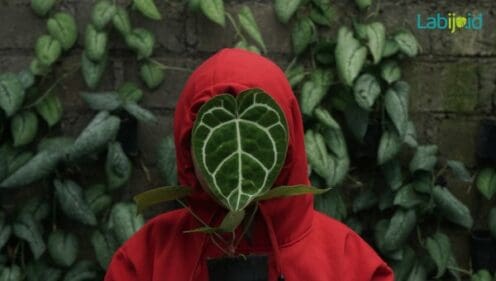The Monstera Peru (Monstera karstenianum) is gaining popularity among houseplant enthusiasts due to its distinctive foliage and ease of care.
Monstera Peru does not have fenestrated leaves; instead, its thick leaves have a deep ridge-like texture (similar to some peperomias) and a dark green color. Indoors, this small monstera plant rarely grows taller than 6 to 8 feet, with leaves up to 9 centimeters long.
We also have varigated monstera peru karstenianum available for sale.
Care for Monstera Peru
Remove the bottom 1-2 leaves from the stem, cutting to reveal the nodes along the stem, leaving 1-2 leaves on top.
Even though they can be hard to find, monstera Peru plants are surprisingly low-maintenance and do well indoors. They need less light and water than other monstera species, and they grow slowly, so they probably won’t outgrow your space any time soon
You can also grow your Monstera Peru in a hanging basket or planter and let the vines trail downwards.
Light
This plants does not require a lot of light to thrive indoors. They only need receives several hours of bright, indirect light. Avoid areas that receive direct sunlight because their thick leaves are easily sunburned and scorched.
Soil
Monstera peru thrives on rich, airy, well-drained soil. For these monsteras, a mixture of one part coco coir, one part orchid bark, and one part perlite gives the ideal amount of drainage, moisture retention, and nutritional value.
Water
This monstera should not be left in wet soil for a lengthy period of time because it is prone to root rot.
Temperature and Humidity
Monstera Peru is native tropical regions and requires warm, humid temperatures to thrive. Keep temperatures between 60 and 85 degrees Fahrenheit (16 and 30 degrees Celsius) and choose a naturally humid location.
You can also increase humidity around the plant by placing a pebble tray beneath the pot or placing a humidifier nearby.
Fertilizer
During the spring and summer, They likes to be fertilized regularly with a mild, balanced fertilizer. Every 3 to 4 weeks, when you water, put the fertilizer down. Don’t give your Monstera any fertilizer in the winter, when the plant is dormant.
Propagating Monstera Peru
Stem cuttings are an easy way to propagate Monstera Peru. Propagating is an excellent way to get new plants. To propagate, simply follow these simple steps.
- Determine the location of the cutting on the stem. For the best results, each cutting should have 3 to 4 nodes along the stem.
- Cut directly below a node with a sharp pair of scissors or pruning shears.
- Remove the bottom leaves from the stem, cutting to reveal the nodes along the stem, leaving 1-2 leaves on top.
- Fill a small glass or vase halfway with water and submerge the cutting, making sure that the exposed nodes along the stem are buried but the top leaves are above the water.
- Place the cutting in an area with medium to brilliant indirect light and change the water once a week to help it grow.
Common Pests
Fungus gnats, mealy bugs, scale, spider mites, and white flies are among the common houseplant pests that attack the Monstera Peru.
The best way to avoid an infestation is to inspect the plant on a regular basis for signs of pests. If you notice pests on your Monstera Peru, keep it separate from the rest of your houseplants and treat it with the appropriate insecticide until the infestation has subsided.
Common Problems
In general, the Monstera Peru is a low-maintenance, trouble-free houseplant. There are, however, a few common issues that you may encounter as you learn to care for these tropical plants indoors.
Yellow Leaves
Yellow leaves usually indicate that your plant is not getting enough sunlight or that it is overwatered. Make sure your monstera Peru gets several hours of bright, indirect light every day. It should never be placed more than a few feet away from a bright, sunny window, or it will start to show signs of distress, such as yellowing leaves.
To avoid overwatering your plant, wait until the soil has completely dried before watering again.
Faded Leaves
Pale, fading leaves may indicate that your plant is getting too much sunlight, and they may be accompanied by burned or sun-bleached areas on the leaves.
Avoid exposing your Monstera to direct sunlight for extended periods of time. Keep in mind that these monsteras do not require as much light as other Monstera species like as deliciosa or adansonii.
Falling Leaves
If your Monstera Peru is loosing leaves, it is probably overwatered or underwatered. Overwatering will also result in wilted or rotten stems and soil that remains moist for a lengthy amount of time.
You may notice that the leaves have crispy edges or that the soil is dry and compacted if it is underwatered.
FAQ
What’s the difference between Monstera Peru and Monstera Siltepecana?
Second, the Monstera Peru has leaves with deep ridges, whereas the siltepecana monstera has leaves that are more flat. Fenestrations in mature monstera siltepecana leaves are more common than in monstera Peru, therefore it’s worth noting.
